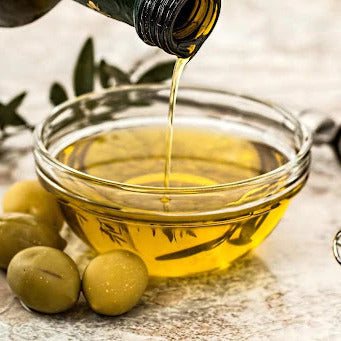The views expressed in the following article are purely opinionated.
Fish and oil go together like peanut butter and jelly (though we wouldn’t recommend pairing all four…). From the incredibly healthy omega-3s in fish oil to the oil used to cook fish, the two foods have both a biological and culinary relationship. In the case of canned seafood, high-quality oils are often used to pack steamed and cured fish. In this article, we’ll review why canneries use oil, the specific appeal of olive oil, and tips for using the extra oil from the tin!
Why Use Oil?
Packing fish in oil preserves (or dare I say, enhances) the flavor and keeps the texture moist and flakey. As with all fats, oil serves to carry certain flavor compounds. Here’s where we get a bit science-y. Flavor chemicals and vitamins can be soluable in water, alcohol, or oil. However, oils and alcohol do the best job of pulling out the flavor of a particular food. This is why dishes like penne alla vodka and herb-infused cooking oils pack such a flavorful punch. Because oils concentrate flavor compounds, packing seafood with oil celebrates the natural flavors in the fish as well as bringing out any other flavorings (peppers, lemon, garlic) added to the mix.
Oil as a Preservative
Oil not only benefits the texture and flavor of canned seafood, but, if used correctly, also acts naturally as a preservative. Oil naturally acts as a barrier between the food and the air. Combined with a sealed can, oil prevents discoloration, spoilage, and preserves the overall quality of the food. However, oil can degrade when exposed to light or oxygen for too long (this is why olive oil is stored in dark bottles). Proper sanitation is imperative for canning with oil because some bacteria thrive in low oxygen environments and can cause botulism.

Delicious Fresh, Delicious Canned
Canning fish serves to seal in its flavor and freshness. So, if you have high-quality, delicious fish to start, that delicacy will remain even if you pop open a tin months (or years) later. On the other hand, if the seafood isn’t at peak freshness or cooked to perfection, the canned product won’t stand up to the test of time. In addition to looking for seafood preserved in olive oil, you also want to look for canneries that value fresh and delicious products up front. Brands like Bela and Briosa all catch their fish sustainably and put a lot of intention behind the smoking, cooking, and curing before the seafood is sealed in a can.
Why Olive Oil?
Canned seafood is often preserved in olive oil. But why? If you’ve ever been struck by the paradox of choice in your grocery store’s oil and vinegar aisle, we get you! There are so many types of oil out there, and so many options of each kind. So why do canned fish gourmands around the world rely so heavily on olive oil? What makes this Mediterranean fruit pair so well with fish?
A Spectrum of Flavor
First, all culinary oils exist on a spectrum of flavor. Some oils bring a punch of flavor. Walnut oil, avocado oil, or coconut oil, for example, taste subtly like their origin plants. Roasted pumpkin seed oil has a strong smokey, earthy taste. On the other hand, oils like safflower oil and grapeseed oil are particularly mild in flavor.
Olive oil falls somewhere in the middle of this flavor spectrum. They can come across with notes of fruit, grass, butter, and even spice! These subtle flavors of olive oil tend to lean on the more savory side, and complement the umami taste of seafood. Additionally, high quality olive oil contains many of the same omega-3 fatty acids found in seafood. Because of their shared nutrients, olive oil and fish pair exquisitely as canning partners.

Olive oil processing. Image by Taken on Pixabay.
The EVOO Difference
But not just any olive oil will do. Depending on the ripeness of the olives and the process to extract the oil, the result can vary. To extract the oil from the olives, the entire fruit goes through the process of malaxation. A big, bizarre word, malaxation refers to churning the mashed olives to allow the oil to coalesce. The oil pressed from the olives immediately after harvesting is called extra virgin olive oil (EVOO), because it doesn't go through any additional refining. Without the extra processing, EVOO retains more flavor and more nutrients compared to its refined counterparts. When buying canned sardines or tuna, look for brands that explicitly use extra virgin olive oil!
Overall, extra virgin olive oil pairs well with canned seafood because of its cohesive flavor profile and nutrients.
How to Use that Extra Oil
If you are a canned fish a-fish-ionado like us, you may often find yourself with a can full of oil after you’ve enjoyed a delightful lunch of sardines on sourdough. But what do you do with all that excess? It seems like a waste to throw it in the trash, and any plumber will warn you against pouring it down the drain. Never fear! Here are a few ideas and recipes that take full advantage of that delightfully flavorful oil.
Use It for Cooking
The extra umami flavor of olive oil from a can of tuna or sardines makes the perfect pairing for so many cooking projects! Start simple by sautéing some onions or garlic in the oil for the most delectable smells and tastes of your life. Convinced yet? Try to drizzle the oil over your pasta or mash it into potatoes. Absolutely delicious!
Make a Salad Dressing
Many cans of fish leave you with quite a bit of oil – more than enough for a quick sauté or scant drizzle. If you are really searching for ways to use up the oil, try a salad dressing! Mix it with a bit of lemon juice and some dijon mustard. It goes well with everything from a simple side of arugula to a large dinner salad with some of those sardines thrown in!
Curious about different kinds of canned seafood? Read more about the wealth of flavor from the Iberian Peninsula here!
A Match Made in Iberia
From the time Nicolas Appert developed the method of preserving food in sealed cans to support French armies, the process of canning took the world by storm. Along the coast of Portugal and Spain (the Iberian peninsula), the vast supply of small fish lent itself naturally to canning. And with access to a succulent supply of olive oil from the Mediterranean, packing fish in oil was deliciously logical. The enhancements of flavor and texture prove that the chemistry is undeniable. Try for yourself! Check out the selection of fish canned in olive oil at TinCanFish.
[Featured Image by stevepb on Pixabay.]


